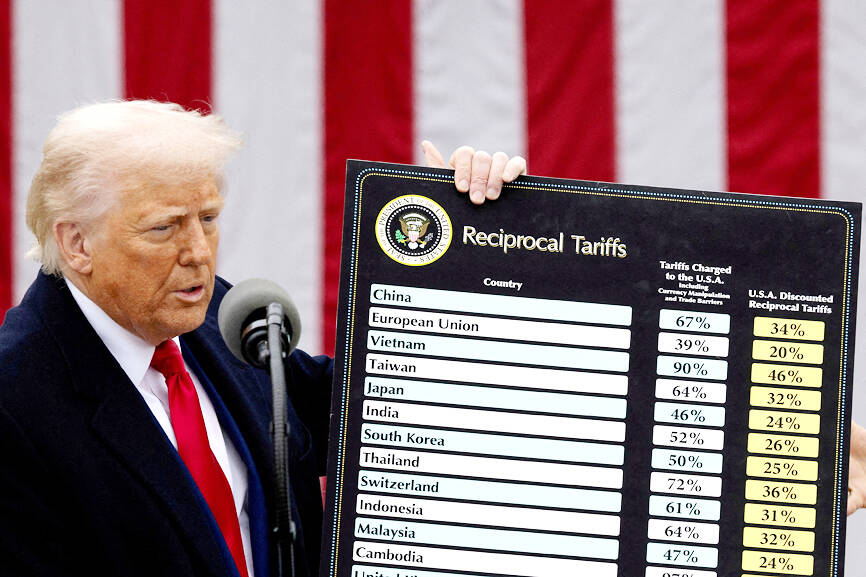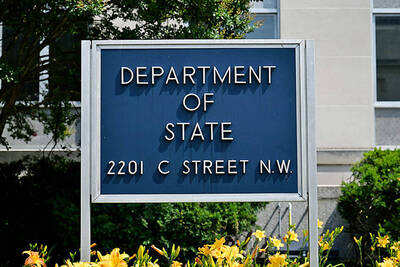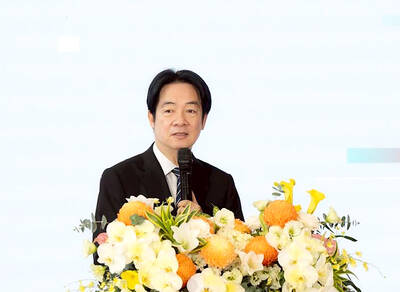Taiwan and the US have completed “technical consultations” regarding tariffs and a finalized rate is expected to be released soon, Executive Yuan spokeswoman Michelle Lee (李慧芝) told a news conference yesterday, as a 90-day pause on US President Donald Trump’s “reciprocal” tariffs is set to expire today.
The two countries have reached a “certain degree of consensus” on issues such as tariffs, nontariff trade barriers, trade facilitation, supply chain resilience and economic security, Lee said.
They also discussed opportunities for cooperation, investment and procurement, she said.

Photo: Reuters
A joint statement is still being negotiated and would be released once the US government has made a final decision, she added.
Taiwan’s tariff negotiation team remains in Washington, Lee said.
A trade delegation led by Vice Premier Cheng Li-chun (鄭麗君) has gone through four rounds of negotiations with US officials, including US Trade Representative Jamieson Greer and US Secretary of Commerce Howard Lutnick, a statement issued by the Cabinet said.
The team prioritized protecting national interests, safeguarding local industries, promoting public health and ensuring food security, Lee said.
“We will firmly uphold our position,” she added.
They also promoted balanced bilateral trade and expanding cooperation with the US in fields such as technology and national security, she said.
Tariff rates are being released for countries around the world, with East Asian neighbors Japan and South Korea last week each securing a reduced tariff deal of 15 percent as opposed to the 25 percent proposed in April.
Vietnam was granted 20 percent and the Philippines 19 percent, down from 46 percent and 20 percent respectively.
The US initially proposed a blanket tariff of 32 percent on most Taiwanese goods, with a separate rate to be negotiated for semiconductors.
Trump’s team has so far only offered Taiwan a “best rate tariff” without specifying the number, said a person familiar with the talks, who added that Taiwanese officials assume that is about the 15 percent tariff Japan was given.
The US is also demanding more investment, after Tokyo’s offer of a US$550 billion fund, the person added.
Shortly after Trump’s announcement in April, which simultaneously targeted more than 100 countries and regions with different tariff rates, President William Lai (賴清德) indicated his administration’s willingness to discuss “bilateral zero tariffs” with the US.
Some industries, particularly those in agriculture, expressed concerns over that idea, saying that opening up the Taiwanese market to US agricultural products would harm domestic producers.
Taipei has also expressed its intention to increase purchases of US goods, raise defense spending and address concerns flagged by Washington over transshipments and trade imbalances.
Additional reporting by Chung Li-hua and Bloomberg

MISINFORMATION: The generated content tends to adopt China’s official stance, such as ‘Taiwan is currently governed by the Chinese central government,’ the NSB said Five China-developed artificial intelligence (AI) language models exhibit cybersecurity risks and content biases, an inspection conducted by the National Security Bureau (NSB) showed. The five AI tools are: DeepSeek, Doubao (豆包), Yiyan (文心一言), Tongyi (通義千問) and Yuanbao (騰訊元寶), the bureau said, advising people to remain vigilant to protect personal data privacy and corporate business secrets. The NSB said it, in accordance with the National Intelligence Services Act (國家情報工作法), has reviewed international cybersecurity reports and intelligence, and coordinated with the Ministry of Justice Investigation Bureau and the National Police Agency’s Criminal Investigation Bureau to conduct an inspection of China-made AI language

BOOST IN CONFIDENCE: The sale sends a clear message of support for Taiwan and dispels rumors that US President Donald Trump ‘sold out’ the nation, an expert said The US government on Thursday announced a possible sale to Taiwan of fighter jet parts, which was estimated to cost about US$330 million, in a move that an expert said “sends a clear message of support for Taiwan” amid fears that Washington might be wavering in its attitude toward Taipei. It was the first announcement of an arms sale to Taiwan since US President Donald Trump returned to the White House earlier this year. The proposed package includes non-standard components, spare and repair parts, consumables and accessories, as well repair and return support for the F-16, C-130 and Indigenous Defense Fighter aircraft,

CHECKING BOUNDARIES: China wants to disrupt solidarity among democracies and test their red lines, but it is instead pushing nations to become more united, an expert said The US Department of State on Friday expressed deep concern over a Chinese public security agency’s investigation into Legislator Puma Shen (沈伯洋) for “secession.” “China’s actions threaten free speech and erode norms that have underpinned the cross-strait ‘status quo’ for decades,” a US Department of State spokesperson said. The Chongqing Municipal Public Security Bureau late last month listed Shen as “wanted” and launched an investigation into alleged “secession-related” criminal activities, including his founding of the Kuma Academy, a civil defense organization that prepares people for an invasion by China. The spokesperson said that the US was “deeply concerned” about the bureau investigating Shen

‘TROUBLEMAKER’: Most countries believe that it is China — rather than Taiwan — that is undermining regional peace and stability with its coercive tactics, the president said China should restrain itself and refrain from being a troublemaker that sabotages peace and stability in the Indo-Pacific region, President William Lai (賴清德) said yesterday. Lai made the remarks after China Coast Guard vessels sailed into disputed waters off the Senkaku Islands — known as the Diaoyutai Islands (釣魚台) in Taiwan — following a remark Japanese Prime Minister Sanae Takaichi made regarding Taiwan. Takaichi during a parliamentary session on Nov. 7 said that a “Taiwan contingency” involving a Chinese naval blockade could qualify as a “survival-threatening situation” for Japan, and trigger Tokyo’s deployment of its military for defense. Asked about the escalating tensions